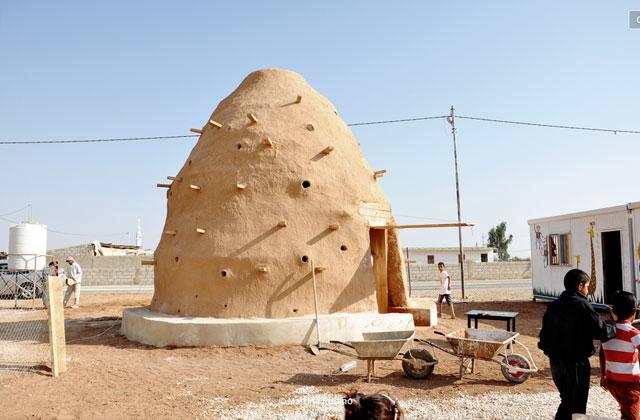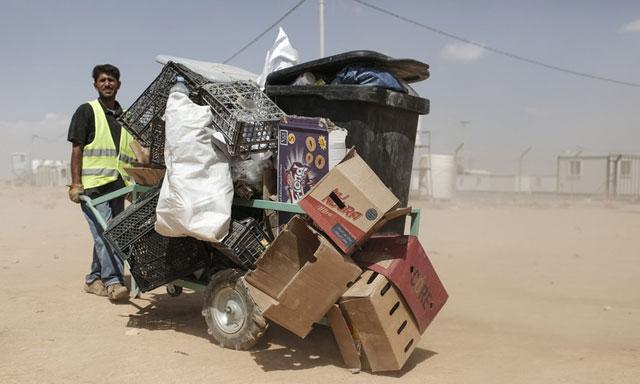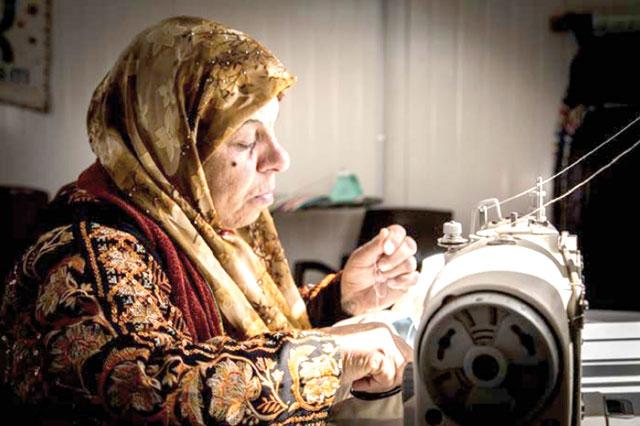You are here
Innovative building gives Zaatari residents cool, livable community centre
By Camille Dupire - Jul 05,2018 - Last updated at Jul 05,2018

The SuperAdobe structure in Oxfam’s community centre in Zaatari camp is made of natural, easy to access material (Photo courtesy of Oxfam/Alix Buck)
ZAATARI — Residents of Zaatari’s eighth district now have the chance to enjoy a comfortable, entertaining summer, as Oxfam recently inaugurated its new community centre desgined according to the pionnering SuperAdobe building technique.
In the presence of representatives from UNHCR, UNICEF and the Syrian Refugee affairs directorate, Oxfam country Director Nivedita Monga unveiled the first of its kind earth bag building inside the camp.
“Seven years after the Syria crisis began, refugees in Zaatari camp continue to live in temporary caravans. Unable to return home, life is hard for them. There is a need to adopt a new approach to temporary housing; one that is more durable, livable and mindful of human dignity,” she stated at the inaugurating event.
A form of earth bag architecture developed by architect and CalEarth founder Nader Khalili, the SuperAdobe uses long sandbags, barbed wire, on-site earth and a few simple tools to create easy to make, more livable built environment, according to online sources.
The revolutionary building system, which been published by NASA and endorsed by the United Nations, helps gain four to five degrees in the winter and lowers the temperature by six to seven degrees in the summer, as compared to traditional buildings, explained Hanin Abu Mahfouz, the project lead architect at Oxfam Jordan.
For Diaa’ Ibrahim, a Syrian cash-for-work volunteer who participated in the construction of the structure, this project was “useful and very needed”. “I have been living in a caravan for three years in the camp. The caravan is humid, it leaks water in winter. In summer, the heat is over 45 degrees,” he said.
“Due to the limited choice of building methods and materials, as well as the harsh environment characterised by hot summers and cold winters, traditional building techniques are not viable options for construction inside the camp,” Abu Mahfouz told The Jordan Times, noting that “quick to construct, cost-effective, the SuperAdobe building method was used to counter the difficult conditions stemming from pre-fabricated caravans housing refugees in Zaatari”.
But the project was also a way to involve Syrian workers in the construction of the centre, providing them with work and skill learning opportunities.
The new District 8 community centre was entirely built by Syrian cash-for-work volunteers, who used readily available building materials including sand gathered on site, plastic bags, barbed wire, limestone and bamboo.
“At the beginning of the project, we didn’t have any idea on how we could build this structure,” recounted Hassan Altarshan, a Syrian volunteer with the project, stressing “we have experience but we still needed to learn more as it is something we had never done before.”
“Most of these people used to work with these materials back in Syria, so they know how to handle them. They just needed a bit of professional help with the typology and the building technique,” Emergency Architecture and Human Rights Director Michele di Marco told The Jordan Times recently, after his organisation’s SuperAdobe construction in Zaatari village won a global architecture prize.
According to Abu Mahfouz, "such an approach is a quick and efficient solution to temporary housing in the current and continued crisis. Compared to caravans, they are faster to deliver, cheaper, more durable, and easily adaptable.”
SuperAdobe structures can be used for over 10 years, experts indicated, further stressing that, despite their longevity, the buildings can be demolished for low-cost and with minimal environmental impact or waste. “In this way, the structures do not challenge the ‘temporary’ status of the camps in Jordan,” an Oxfam official told The Jordan Times after the inauguration.
Expressing his hapiness to see the result of their joint work, Ibrahim said: “When I return back to Syria, I want to build a house like this. Our house in Syria was destroyed because of the war and I want to build a house for me to live in.”
The Oxfam team voiced its hopes to move forward and build another community centre inside the camp, with the participation of Syrian women this time, so as to “enhance their knowledge and skills in building techniques”.
Related Articles
AMMAN — Stricken by the realisation that two out of three refugee children tend to drop out of education due to the lack of schools located
AMMAN — Despite the national strategy implemented to improve the management of Municipal Solid Waste (MSW), Jordan continues to suffer from
AMMAN — With some 5,000 cash-for-work positions available for nearly 80,000 Syrian refugees living in Zataari camp, the competition for work














